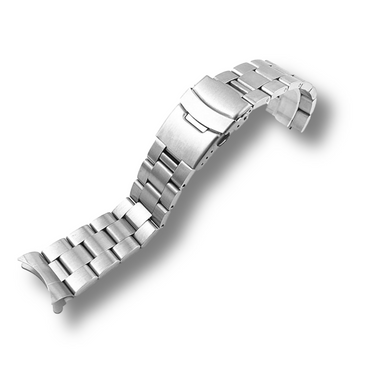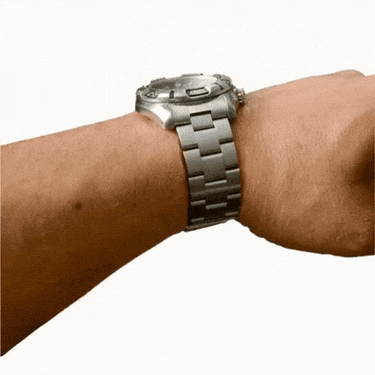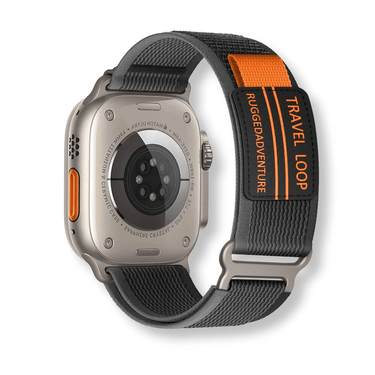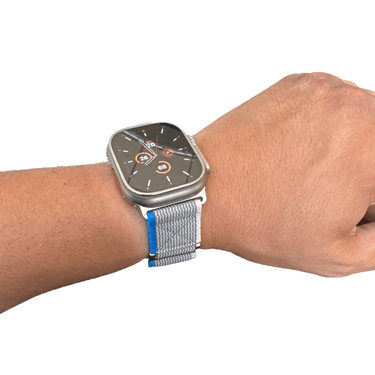In the world of diving, having a reliable timepiece is crucial. Watches designed for divers are not only waterproof but also provide information on elapsed diving time and decompression stops.
However, one of the most important aspects of a dive watch is its band or strap. A good quality band is essential to ensure that the watch stays securely fastened to the diver's wrist underwater.
The Importance of Dive Watchbands for Divers and Watch Enthusiasts
Dive watchbands are not just functional accessories; they can also be fashion statements for watch enthusiasts. The right band can complement an outfit or express an individual's personal style. For divers, a sturdy and durable band can mean the difference between a successful dive and losing their expensive timepiece in the water.
Brief History of Nylon Dive Watchbands
Nylon bands have been around since World War II when soldiers used them as straps for their field watches. After the war, nylon straps became more popular with civilians due to their durability, affordability, and variety of colors and patterns available. In 1973, NATO (North Atlantic Treaty Organization) introduced its strap specification code for use by military personnel across member countries; this specification included nylon bands that met strict criteria regarding strength, durability, and reliability under extreme conditions.
Purpose and Scope of the Guide
This guide aims to help divers and watch enthusiasts understand why choosing a high-quality nylon dive watchband is essential when it comes to comfort, functionality, style expression as well as preserving your investment in your timepiece. It will cover various topics like what makes nylon such an excellent material choice compared to other materials such as rubber or metal; how to choose the right size based on your wrist’s dimension; cleaning techniques that will help extend its lifespan; common mistakes to avoid when wearing or maintaining your nylon dive watchband; and popular brands and models that divers and watch enthusiasts prefer.
Understanding Nylon Dive Watchbands
The Definition and Characteristics of Nylon as a Material for Dive Watchbands
Nylon is the most common material used for dive watchbands due to its durability, flexibility, and affordability. The synthetic fiber is known for its high strength-to-weight ratio, resistance to abrasion and tear, and ability to withstand exposure to water and sunlight.
Nylon has several unique characteristics that make it an ideal choice for dive watchbands. Firstly, it is extremely lightweight, making it comfortable to wear during extended periods of diving.
Secondly, nylon has excellent tensile strength which ensures that the band will not snap or break easily in rough water conditions or while handling equipment. Additionally, nylon has a high degree of elasticity which enables it to stretch and flex without losing its shape or creasing.
Advantages and Disadvantages of Nylon Dive Watchbands Compared to Other Materials
When compared with other materials such as rubber, leather or metal, nylon dive watchbands have both advantages and disadvantages. One advantage of nylon bands is their versatility in terms of style and color options available. Due to their popularity among divers around the world, there are endless options when it comes to patterned designs with different colors that can suit any taste.
Another advantage of nylon dive watchbands compared with other materials is their breathability. Nylon bands allow air circulation around the wrist reducing sweating on hot days during outdoor activities like diving.
On the other hand, one disadvantage can be that nylon bands may not be suitable for formal events due to their casual appearance compared with leather or metal alternatives. Additionally, some types of nylon bands may feel scratchy against the skin if they are made from low-quality materials rather than premium woven threads.
Types of Nylon Weave Patterns Used in Dive Watchbands
Nylon dive watchbands come in various weave patterns, but the most common are NATO, Zulu, and Perlon. NATO bands have a unique design with extra length to wrap around the wrist or over a diving suit. They have one continuous loop through the watch lugs, making them more secure than straps with spring bars.
Zulu bands are similar to NATO, but they are thicker and heavier due to their double-layered construction with metal loops at each end. The Perlon band has a fine weave pattern which is lightweight and breathable making it an ideal option for everyday wear.
Nylon dive watchbands offer several advantages compared to other materials due to their lightness, durability, and affordability. Each weave pattern in nylon bands has its own unique features that suit different activities or styles of divers or watch enthusiasts who prefer wearing them as everyday accessories.
Choosing the Right Nylon Dive Watchband
Factors to consider when choosing a nylon dive watchband (e.g., size, color, thickness)
One of the most important factors to consider when choosing a nylon dive watchband is the size. The band must fit comfortably and securely around your wrist to ensure safety while diving. Most bands come in standard sizes, but some manufacturers offer customized bands for people with non-standard wrists.
Another important factor is the color of the band. While this may seem like a minor detail, it can actually have an impact on your visibility underwater.
For example, bright colored bands can make it easier for your dive partner or team to spot you during low visibility conditions. Thickness is also a consideration when selecting a nylon dive watchband.
A thicker band will generally be more durable and long-lasting, but may not be as comfortable as a thinner band for extended periods of wear. It's essential to find a balance between thickness and comfort that works for you.
Matching the Style and Function of the Band with the Type of Diving Activity or Environment
The style and function of your nylon dive watchband should match the type of diving activity or environment you'll be in. For example, if you'll be diving in cold water, you may want a thicker band that will keep your watch securely on your wrist while wearing gloves.
If you're going for recreational diving in shallow waters or snorkeling, then a thinner band may suffice as there won't be much pressure exerted on it during these activities. For technical diving activities involving extended time underwater and deeper depths where higher levels of pressure are experienced, opt for more secure double-fold over single-fold buckles that typically come with NATO style straps.
Recommendations on Popular Brands and Models for Different Budgets
There are many popular brands to choose from when selecting a nylon dive watchband. Some of the most reputable brands include Maratac, Erika's Originals, and Crown & Buckle. For those on a budget, there are many options under $20 that can still provide quality and durability.
Brands like Clockwork Synergy and Barton also offer an affordable range of high quality NATO straps. For those with a higher budget, premium brands like Omega and Rolex offer their own version of custom nylon straps for their watches.
These high-end straps provide additional branding prestige while offering the same functionality as other similar bands. By considering important factors such as the size, color, thickness, style and function when choosing your nylon dive watchband paired with the right financial capabilities gives you the best investment in terms of comfortability, durability & protection for your diving activities.
IV. Maintaining Your Nylon Dive Watchband
Proper Cleaning Techniques for Your Nylon Band
Nylon dive watchbands are relatively easy to clean and maintain. However, there are some do's and don'ts to ensure the longevity of your band. First, it is essential to remove the band from your watch before cleaning it.
This will allow you to thoroughly clean both the band and your watch separately. Next, use a soft-bristled brush or cloth with mild soapy water to gently scrub away any dirt or grime on your nylon band.
Avoid using harsh chemicals, bleach or any abrasive cleaners as they can damage the material over time. After cleaning, rinse the band with cool water and let it air dry completely before reattaching it to your watch.
Tips on How to Extend Its Lifespan
Here are some tips on how you can extend the lifespan of your nylon dive watchband: 1. Rotate Your Bands: Alternating between two different bands can help reduce wear and tear while also allowing each one sufficient time to dry out after use.
- Avoid Excessive Moisture Exposure: Although nylon is a highly durable material, prolonged exposure to water or moisture can lead to mold growth or rusted hardware fittings that may eventually weaken the fabric. 3. Store Properly: When not in use, store your bands in a cool, dry place and avoid exposing them directly under sunlight as UV rays can cause discoloration.
Common Mistakes To Avoid
Here are some common mistakes people make when maintaining their nylon dive watchbands: 1 . Using Harsh Cleaners: Harsh chemicals like bleach or ammonia-based products should never be used when cleaning nylon bands as they may cause discoloration or weaken its fibers over time. 2 . Wearing Wet Bands: It's important to let your bands dry out completely before wearing them again, as moist or damp bands can cause mold growth and rust.
3 . Overstretching: Nylon bands are relatively flexible but can lose their shape if excessively stretched. Be careful when putting the band on and avoid pulling too hard on any one area.
Conclusion
Recap on why choosing a good quality band is important
Choosing the right nylon dive watchband is crucial for both divers and watch enthusiasts. A good quality band can enhance the functionality and durability of your dive watch, while also adding an element of style and personalization.
Nylon is a versatile material that offers many benefits to divers, including high strength, water resistance, and breathability. When selecting a band, consider factors such as size, color, thickness, and weave pattern to ensure a good fit for your wrist and diving needs.
Final thoughts on selecting and maintaining
As you embark on your journey to choose the perfect nylon dive watchband, remember that there are many options available on the market today. Take your time to research different brands and models that fit your budget and preferences. Keep in mind that proper maintenance is key to prolonging the lifespan of your nylon band.
Regularly clean it with mild soap and water, avoid exposing it to harsh chemicals or extreme temperatures, and store it in a cool dry place when not in use. Overall, investing in a high-quality nylon dive watchband can make all the difference when exploring underwater worlds or going about daily life with style.
With this ultimate guide in hand, you are now equipped with all the information you need to make an informed decision when selecting a band for your beloved dive watch. Dive safe!



























